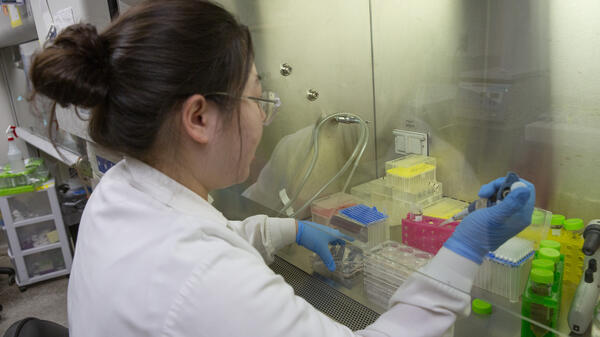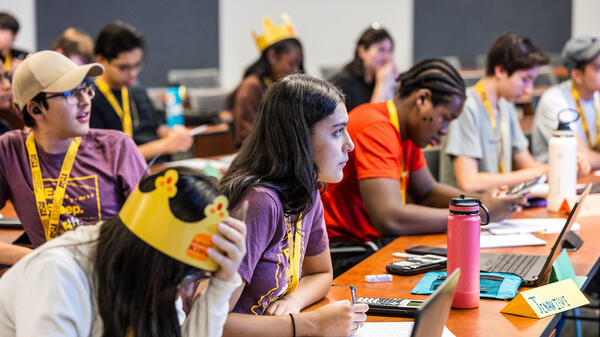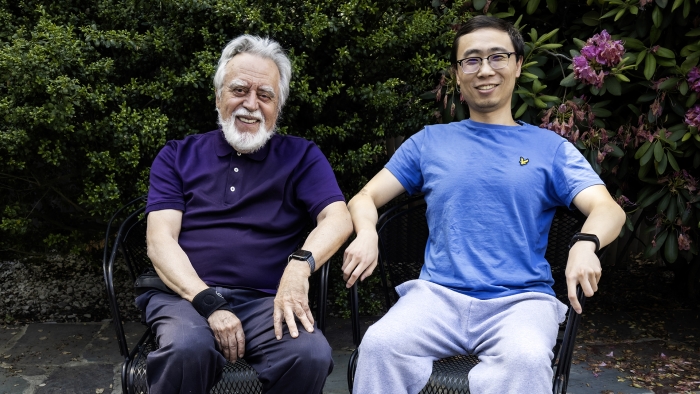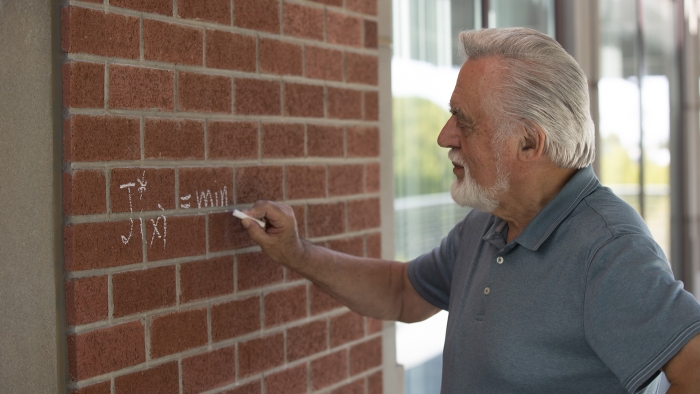Acclaimed mathematician awarded provisional AI patent
ASU's Dimitri Bertsekas creates new algorithms to improve predictive text tools

Renowned mathematician Dimitri Bertsekas, a professor of computer science and engineering in the School of Computing and Augmented Intelligence, part of the Ira A. Fulton Schools of Engineering at Arizona State University, has developed new algorithms to improve the predictive capabilities of artificial intelligence systems. Image generated by artificial intelligence
The majority of Americans are now familiar with ChatGPT, a computer program powered by artificial intelligence, or AI, that generates text and dialogue in response to text prompts provided by a user. Its service has an estimated 180 million registered users, with about 1.6 billion website visitors per month.
A groundbreaking collaboration with the tool’s maker, OpenAI, is underway at Arizona State University. As part of the AI Innovation Challenge, students, researchers and faculty members across the university are developing more than 100 projects in 14 schools using ChatGPT Enterprise to explore diverse topics including ethics, scientific advancement and data analysis.
But while people all over the world are adjusting to this new technology and putting it to work to enrich their daily lives, researchers in the Ira A. Fulton Schools of Engineering at ASU are looking to the future, driving innovation in the AI arena.
Dimitri Bertsekas, professor of computer science in the School of Computing and Augmented Intelligence, part of the Fulton Schools, has been awarded a provisional patent for the development of new algorithms that improve the predictive features of tools like ChatGPT. The goal is to generate the most accurate, helpful results for the user. The new work builds on the famed mathematician’s prior research in reinforcement learning.
Predicting what comes next
The acronym GPT refers to "generative pretrained transformer." GPTs are a type of artificial intelligence inspired by the human mind. A software program is given access to large amounts of text that describe a broad range of subjects. This process — referred to as "pretraining" — provides the AI system with context to help it understand and process the input it receives. The program then combines its pretraining with specific information it gathers from the user, transforming the data and generating something new.
“Currently, software like ChatGPT use a ‘next word prediction’ principle,” Bertsekas says. “Based on the text that the GPT has seen, it generates a set of likely next words. It expands the text it has generated one word at a time, looking exclusively to the past.”
Bertsekas notes that many people already have experience with this technology using the predictive text features of their smartphone’s text messaging program, even if they have not specifically interacted with a chatbot.
Working with Yuchao Li, a postdoctoral research scholar in the School of Computing and Augmented Intelligence, Bertsekas has developed algorithms that harness the power of complex mathematics to enhance the current predictive process by looking not only to the past but also to the future.
“Our algorithms predict next words by looking at the preceding text but also by anticipating future word choices to improve metrics of quality, such as coherence and grammar,” Bertsekas says.
Most likely to succeed
An algorithm is a set of step-by-step instructions, sometimes including dense equations, that is used to solve a problem or perform calculations. In his early work at the Massachusetts Institute of Technology, Bertsekas pioneered several types of important mathematical algorithms, including auction algorithms for optimizing the operation of networks of resources. These algorithms have been widely used in the power, communication and transportation sectors.
The new GPT algorithms are the next steps in Bertsekas’ work on a type of AI theory known as reinforcement learning. The key idea there is to teach software to understand the relationship between a system’s immediate actions and anticipated future outcomes. Self-driving cars must make correct maneuvers now to avoid future collisions. Google’s AlphaGo, an AI-powered player designed to master the ancient Chinese game of Go, has learned to predict future opponent moves and strategize accordingly.
Bertsekas and Li say this predictive technique, which they have dubbed "the rollout approach" and describe in their recent paper, “Most Likely Sequence Generation for n-Grams, Transformers, HMMs, and Markov Chains, by Using Rollout Algorithms,” could produce nearly optimal generative results. The researchers also note that the algorithms are efficient and could be used to save computational resources, addressing the emerging AI sustainability challenges.
While it was a love of theoretical mathematics that attracted Li to the project, he feels that there are many potential real-world applications of his work with Bertsekas.
“The algorithmic ideas can be applied in many ways,” Li says. “For example, they could help produce better results in AI systems that deal with language translation and health care data.”
Potential applications in biometrics, where researchers are turning to predictive artificial intelligence for help in sequencing genes, are especially exciting.
From the classroom to the courthouse
The new algorithms may have received a provisional patented seal of approval, but the project began in the classroom. Bertsekas and Li developed the ideas while teaching CSE 691: Topics in Reinforcement Learning, a graduate course in the Fulton Schools.
“It’s a reflection of the synergy between teaching, research and learning,” Bertsekas says.
Graduate students attend lectures on the developing work, receiving critical insights into research in progress.
The patent is also an important part of ASU’s commitment to innovation. The university ranks No. 7 in the U.S. for patents and has been repeatedly ranked No. 1 in innovation by U.S. News and World Report.
Artificial intelligence patents are especially important. The National Science Foundation has reported that the U.S. currently lags behind global competitors in AI patents.
Bertsekas’ patent is another example of the faculty excellence that students tap into when they study in the Fulton Schools.
“Of course, Dimitri Bertsekas is a luminary figure in mathematics and computer science who literally wrote the textbook on reinforcement learning,” says Ross Maciejewski, director of the School of Computing and Augmented Intelligence. “His new algorithms are part of the influential artificial intelligence work being done here in the school and are sure to make an impact in this fast-changing field.”
More Science and technology

Chilling discovery: Cold-sensing protein may pave the way for safer pain relief
For millions of people worldwide who live with chronic pain, the only treatments currently available often rely on opioids, which carry the risks of addiction and overdose. However, new research…

Harnessing benefits of stem cells for heart regeneration
Mehdi Nikkhah, an associate professor of biomedical engineering in the Ira A. Fulton Schools of Engineering at Arizona State University, and his collaborators at Mayo Clinic in Arizona have been…

Newly accredited ASU summer program opens up STEM opportunities for underrepresented students
It was Monday afternoon. Spotify was playing pop music in the background and the instructor stood behind a lectern wearing a paper Burger King crown. It is not a scene one would expect in a college…

